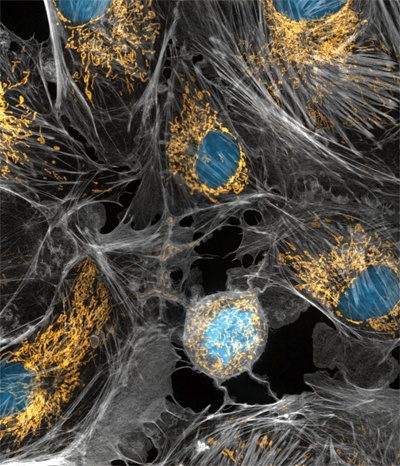MCP: When mitochondria make B cells go bad
B-cell chronic lymphocytic leukemia, or B-CLL, is the most common type of leukemia in adults and primarily affects elderly patients. The disease results from a patient’s bone marrow overproducing immature lymphocytes, a form of white blood cells that fight infections less effectively than their healthy counterparts but survive longer, ultimately overwhelming them and spreading unchecked. Unlike acute leukemia, B-CLL can take several years to cause problems for a patient, but it is less responsive to chemotherapy.
 When mitochondria, highlighted here in cow cells, suffer age-related oxidative damage, they can give rise to chronic lymphocytic leukemia.courtesy of Torsten Wittmann, University of California, San Francisco
When mitochondria, highlighted here in cow cells, suffer age-related oxidative damage, they can give rise to chronic lymphocytic leukemia.courtesy of Torsten Wittmann, University of California, San Francisco
While novel treatments have been developed in recent years, they only target the B cells once they’ve mutated to an immature, cancerous state. To develop treatments for B-CLL that might prevent B cells from becoming cancerous in the first place, researchers led by Christopher Gerner at the University of Vienna and Vienna Metabolomics Center have performed a comprehensive proteomics analysis of B-CLL cells and mature B cells in young and elderly patients. They described their work in a paper in the journal Molecular & Cellular Proteomics.
“It could be nice to not only target the cancer cells, but those cells prone to becoming cancer cells,” Gerner said. “What we actually saw when we compared the young and the elderly donors was a very clear signature of mitochondrial stress and metabolic stress.”
Gerner and colleagues found that B-CLL cells have an increased expression of stem cell-associated molecules and a reduced expression of tumor-suppressing molecules and stress-related serotonin transporters as well as an observed increase in glutamine consumption and beta-oxidation of fatty acid.
This indicated that reactive oxidative species, which are carcinogenic and cause damage to cells, were being upregulated, Gerner said, which would explain why the incidence of mutations that lead to B-CLL increases with age. The researchers hope that the alterations in regulation also may provide a proteomic signature for immunosenescence, the immune system’s natural weakening with age.
Gerner and his fellow researchers plan to continue this research by performing their proteomic analysis on blood samples taken from greater numbers of healthy elderly people and B-CLL patients to ultimatelybe able to test when mitochondria have become predisposed for the disease.
“The pressure on those cells was simply different … and this pressure is something I would like to detect and measure in patients,” Gerner said. “That would be the ultimate aim.”
Enjoy reading ASBMB Today?
Become a member to receive the print edition four times a year and the digital edition monthly.
Learn moreGet the latest from ASBMB Today
Enter your email address, and we’ll send you a weekly email with recent articles, interviews and more.
Latest in Science
Science highlights or most popular articles

Cracking cancer’s code through functional connections
A machine learning–derived protein cofunction network is transforming how scientists understand and uncover relationships between proteins in cancer.

Gaze into the proteomics crystal ball
The 15th International Symposium on Proteomics in the Life Sciences symposium will be held August 17–21 in Cambridge, Massachusetts.

Bacterial enzyme catalyzes body odor compound formation
Researchers identify a skin-resident Staphylococcus hominis dipeptidase involved in creating sulfur-containing secretions. Read more about this recent Journal of Biological Chemistry paper.

Neurobiology of stress and substance use
MOSAIC scholar and proud Latino, Bryan Cruz of Scripps Research Institute studies the neurochemical origins of PTSD-related alcohol use using a multidisciplinary approach.

Pesticide disrupts neuronal potentiation
New research reveals how deltamethrin may disrupt brain development by altering the protein cargo of brain-derived extracellular vesicles. Read more about this recent Molecular & Cellular Proteomics article.

A look into the rice glycoproteome
Researchers mapped posttranslational modifications in Oryza sativa, revealing hundreds of alterations tied to key plant processes. Read more about this recent Molecular & Cellular Proteomics paper.

